Watering
Watering impacts everything from nutrient uptake to root development and overall plant health. Proper watering techniques involve understanding how much water is needed, how often to apply it, and recognizing the signs of both overwatering and underwatering. Mastering these aspects, growers can create an optimal environment that supports strong plant growth and maximizes yields.
Watering Techniques
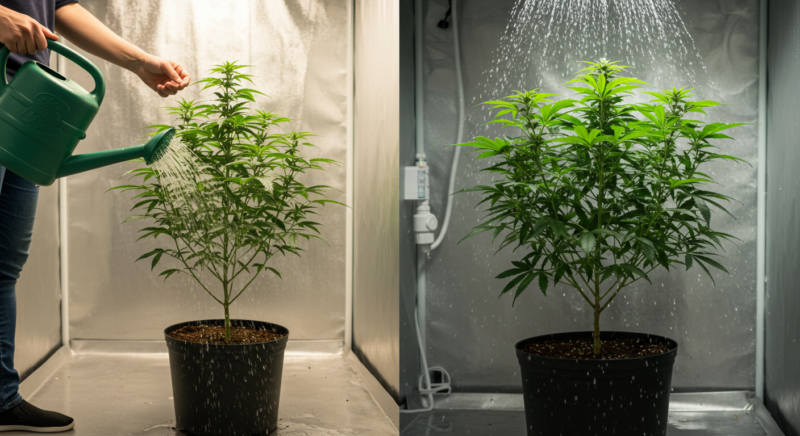
There are different ways to water plants and each method has its own benefits. These methods work well in different growing conditions and plant needs. Selecting the right method can help optimize water use, ensure consistent moisture levels, and support healthy cannabis growth.
Manual Watering
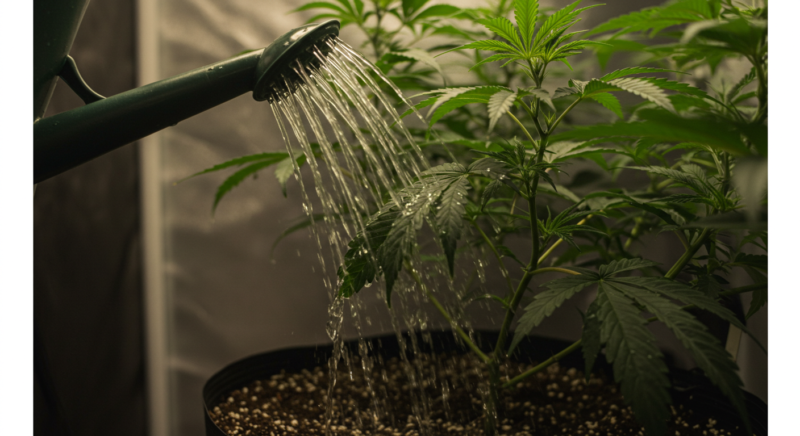
Manual watering is a hands-on approach where growers apply water directly to each plant using a watering can, hose, or similar tool. This method allows for precise control over the amount of water each plant receives, making it especially useful for smaller grow operations or when plants have varying needs. With manual watering, growers can monitor the soil's moisture levels closely and adjust their watering techniques based on immediate observations.
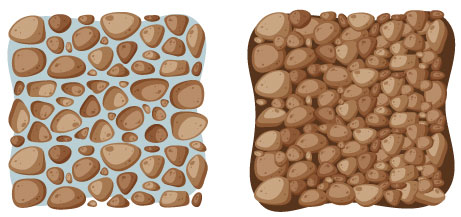
One of the key benefits of manual watering is the ability to tailor water delivery to individual plants. This is particularly important during the early stages of growth when plants are more sensitive to changes in their environment. By watering thoroughly but carefully, growers can ensure that the entire root zone receives adequate moisture without over-saturating the soil.
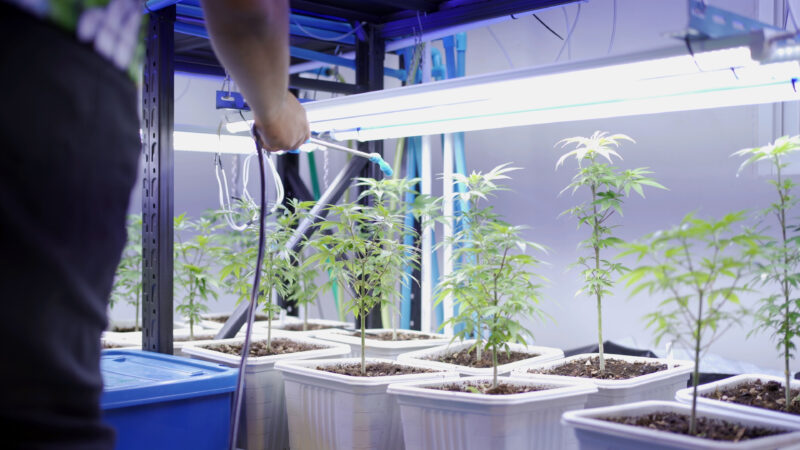
However, manual watering can be time-consuming, especially as plants grow larger and their water needs increase. It requires consistent attention and a good understanding of each plant's needs to avoid common issues such as overwatering or underwatering. Despite these challenges, manual watering remains a preferred method for many growers who value the close monitoring and control it provides.
Irrigation Systems
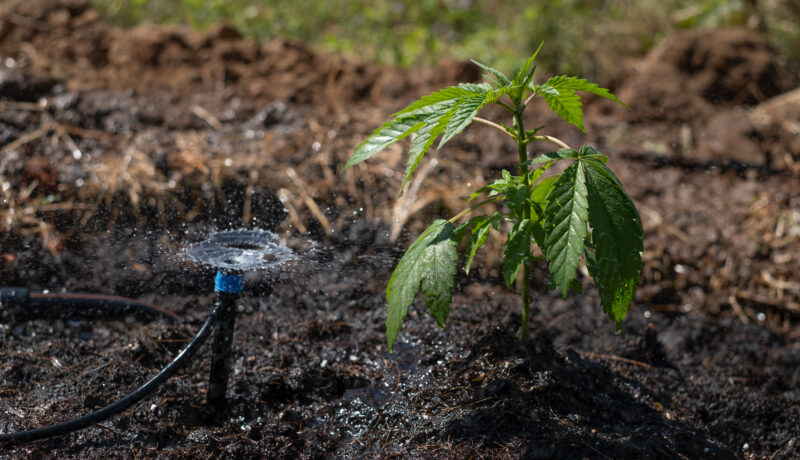
Irrigation systems automate the watering process, offering a more efficient and consistent way to deliver water to cannabis plants. These systems are particularly beneficial in larger grows or in environments where maintaining regular watering schedules by hand would be impractical.
Drip Irrigation
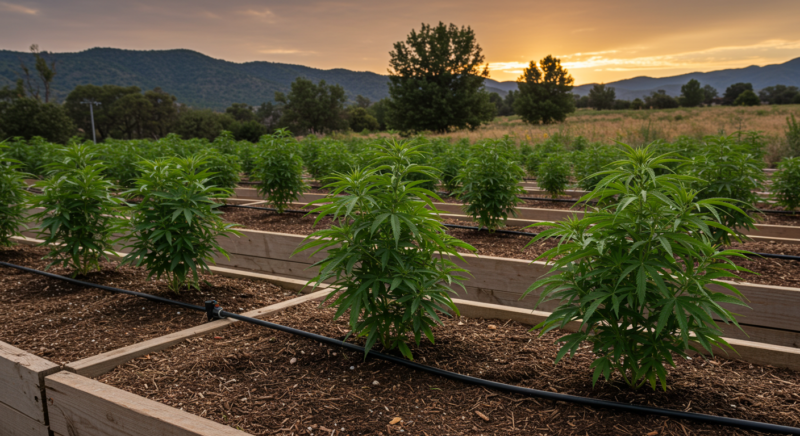
Drip irrigation systems are designed to deliver water directly to the base of each plant through a series of tubes and emitters. This method minimizes water waste by targeting the root zone and reducing evaporation and runoff. Drip irrigation is highly effective in conserving water and ensuring that plants receive consistent moisture levels, which is crucial for steady growth.
Drip Irrigation Setup and Maintenance
Setting up a drip irrigation system involves laying out a network of tubing that connects to a water source. Emitters are placed at the base of each plant to deliver water directly to the roots. A timer can be installed to automate the watering schedule, ensuring plants are watered at the optimal times each day.
- Setup: Begin by planning the layout of your drip irrigation system, considering the number of plants and their placement. Attach the main tubing to a water source, such as a garden hose or a dedicated irrigation line. Position the tubing so that it runs along each row of plants, and insert emitters where needed. Ensure that the emitters are positioned close to the base of each plant.
- Maintenance: Regularly check the system for clogs or leaks, which can occur in the tubing or at the emitters. Clean or replace clogged emitters to ensure even water distribution. Periodically flush the entire system to remove any buildup that might affect performance.
Using Soaker Hoses

Soaker hoses are a type of irrigation system that delivers water along the length of the hose, soaking the soil evenly. This method is similar to drip irrigation but involves less setup and is ideal for small to medium-sized grow operations.
- Setup: Lay the soaker hose on the ground, weaving it around the base of your plants. Ensure that the hose is positioned to cover the entire root zone. Connect the hose to a water source and turn on the water at a low pressure to allow it to seep slowly into the soil.
- Maintenance: Regularly inspect the hose for any blockages or wear and tear. Over time, mineral deposits can clog the tiny pores in the hose, so checking and cleaning the hose periodically is needed. Store the soaker hose properly during the off-season to extend its lifespan.
Flood and Drain Systems
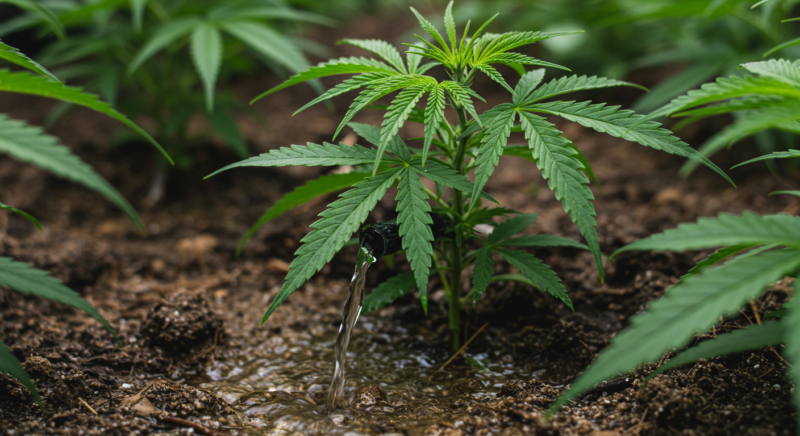
Flood and drain systems, also known as ebb and flow, are commonly used in hydroponic setups but can also be adapted for other growing mediums. In this system, the growing area is periodically flooded with water, which is then allowed to drain back into a reservoir. This cycle provides plants with ample water while also promoting root oxygenation during the draining phase. The alternating wet and dry periods stimulate healthy root growth and help prevent problems associated with constant water saturation, such as root rot.
Rainwater Collection
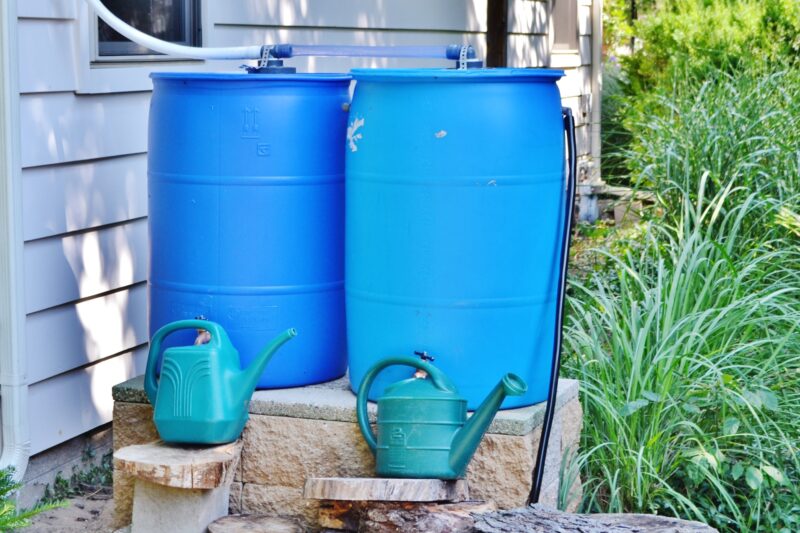
Collecting and using rainwater is an eco-friendly and cost-effective way to water cannabis plants. Rainwater is naturally soft, free of chemicals like chlorine and fluoride, and often contains nutrients beneficial to plants. Setting up a rainwater collection system is straightforward and can significantly reduce reliance on municipal water supplies.
Setting Up a Rainwater Collection System
To set up a rainwater collection system, you'll need a clean, food-grade container, such as a rain barrel, placed under a downspout to collect runoff from your roof. Ensure the container has a lid to prevent debris and insects from contaminating the water. You can connect a hose or spigot to the bottom of the barrel to make watering easier. Filters can be added to prevent debris from entering the barrel, and overflow valves are useful to manage excess water during heavy rains.
Benefits of Using Rainwater
- Chemical-Free: Rainwater is free from the chemicals often found in tap water, such as chlorine and fluoride, which can be harmful to plants over time.
- Cost-Effective: Using collected rainwater reduces reliance on municipal water, lowering utility bills and conserving local water resources.
- Environmental Sustainability: Collecting rainwater is an environmentally friendly practice that reduces stormwater runoff, which can carry pollutants into local waterways.
- Nutrient-Rich: Rainwater naturally contains nitrogen and other nutrients that can benefit plant growth, making it a gentle and effective option for watering.
How Much and How Often to Water
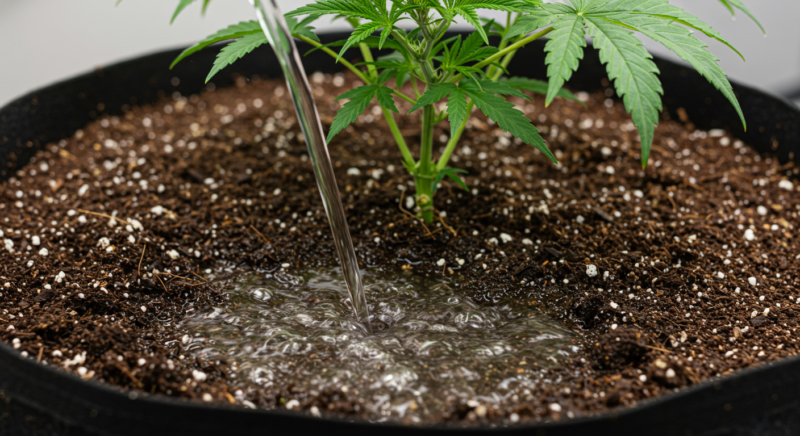
Determining the right amount of water and how frequently to water your cannabis plants is crucial for their development and overall health. The exact requirements can vary depending on several factors, including the plant’s growth stage, the type of growing medium, environmental conditions, and the size of the pots or growing area. By paying close attention to these factors, growers can tailor their watering practices to ensure their plants thrive.
Amount of Water
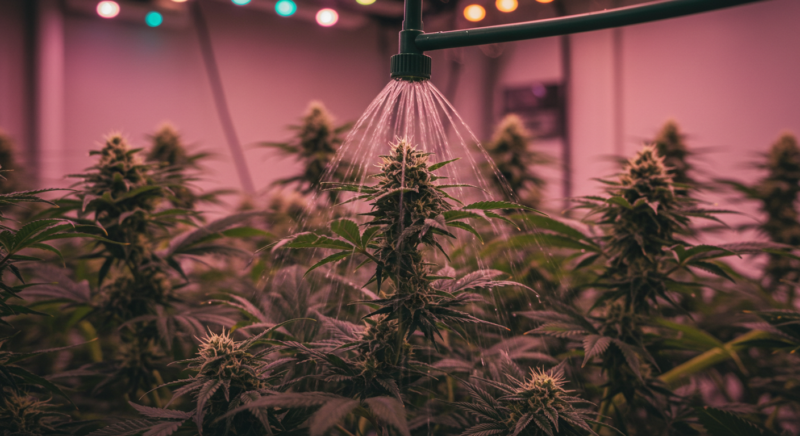
The amount of water a cannabis plant needs largely depends on the plant size and stage. General guideline, plants prefer deep, thorough watering that reaches the entire root system. Shallow watering can lead to weak roots that do not penetrate deeply into the soil, making the plant more susceptible to drought and nutrient deficiencies.
Smaller plants or those in the early stages, less water is needed to keep the soil evenly moist without saturating it. As plants grow larger, their roots expand and require more water to sustain healthy growth. It’s important to water enough so that the soil is thoroughly soaked but not waterlogged. A good practice is to water until you see a small amount of runoff from the bottom of the pot, which indicates that the water has reached all parts of the root zone.
Frequency of Watering
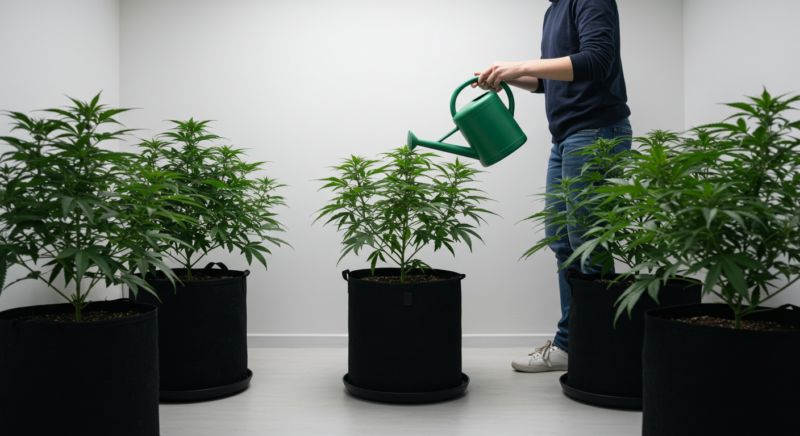
The frequency of watering depends on several variables, including the plant’s size, the type of soil or growing medium, the environment, and the pot size. Generally, cannabis plants do best when the soil is allowed to dry out slightly between waterings. This practice encourages the roots to grow deeper in search of moisture, promoting a stronger root system.
In a typical indoor setup, plants may need watering every 2-3 days, but this can vary widely. During the early stages, when the plant is small, watering might only be necessary once or twice a week. As the plant grows and consumes more water, the frequency will increase. Outdoor plants, depending on the climate, may require more frequent watering, especially during hot or dry periods.
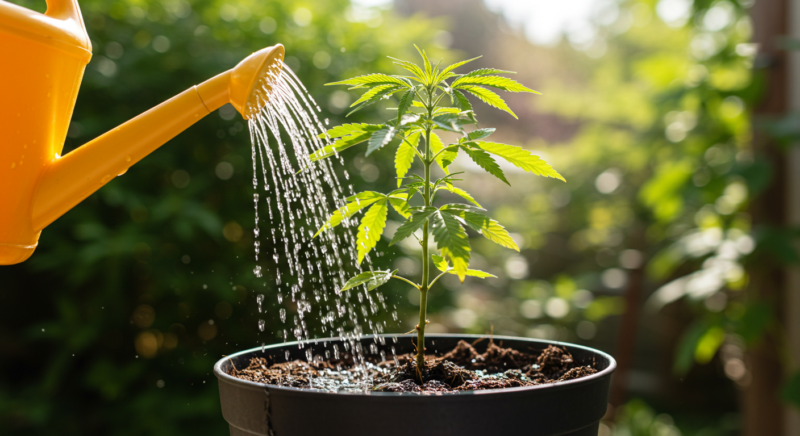
To determine when to water, check the moisture level of the soil. A simple method is to stick your finger about an inch into the soil—if it feels dry, it’s time to water. For larger setups, using a moisture meter can provide a more accurate reading and help avoid overwatering or underwatering.
Growth Stage Considerations
- Seedling Stage: Water lightly and frequently to keep the soil moist but not soaked. The small root system at this stage requires only a small amount of water, usually every 2-3 days, depending on the environment.
- Vegetative Stage: Increase the amount of water as the plant grows. Water deeply, ensuring that the entire root zone is saturated, but allow the top inch of soil to dry out between waterings. Frequency typically increases to every 2-3 days.
- Flowering Stage: Water more frequently as the plant demands more moisture to support bud development. Maintain a balance—water thoroughly but avoid waterlogging the soil. Watering may be required every 1-2 days depending on the environment.
Signs of Overwatering and Underwatering
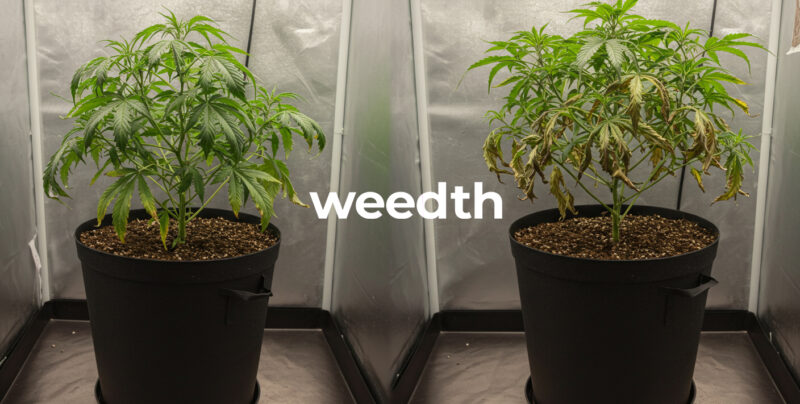
Proper watering is essential for the health and productivity of cannabis plants, but it’s easy to give too much or too little water. Recognizing the signs of overwatering and underwatering early on can help you adjust your watering practices and prevent long-term damage to your plants.
Signs of Overwatering
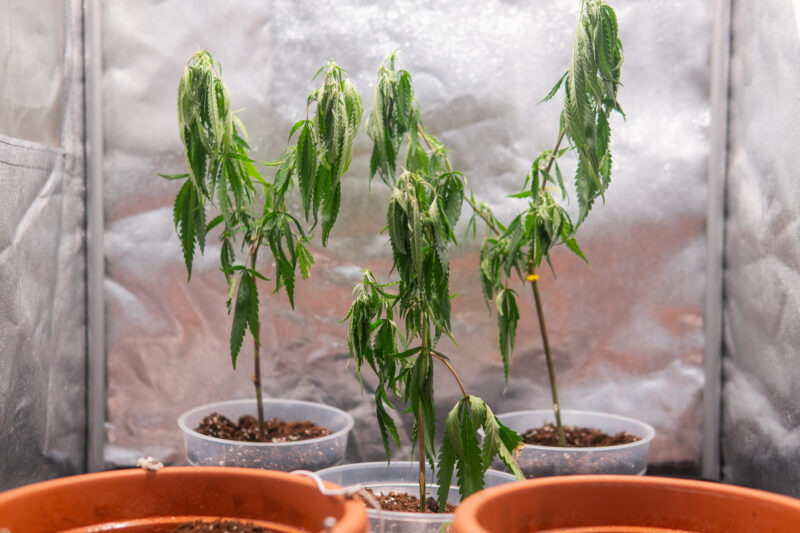
Overwatering is one of the most common mistakes made by cannabis growers, particularly those who are new to cultivation. When plants receive too much water, the soil remains saturated, depriving the roots of oxygen. This lack of oxygen can lead to several problems, most notably root rot, which can severely harm or even kill the plant.
- Wilting with Moist Soil: A classic sign of overwatering is wilting, even though the soil is still wet. Unlike underwatered plants, which wilt due to lack of moisture, overwatered plants wilt because their roots are suffocating.
- Yellowing Leaves: The lower leaves of an overwatered plant often turn yellow and may fall off. This yellowing occurs because the roots are unable to take up essential nutrients from the waterlogged soil.
- Mushy or Swollen Stems: In severe cases, overwatered plants may develop mushy or swollen stems. This is a sign that the plant is retaining too much water and is at risk of developing root rot.
- Root Rot: When roots are consistently exposed to waterlogged conditions, they can begin to rot. Root rot is often indicated by a foul smell and brown or black, slimy roots. This condition can spread quickly and is difficult to reverse once it starts.
Signs of Underwatering
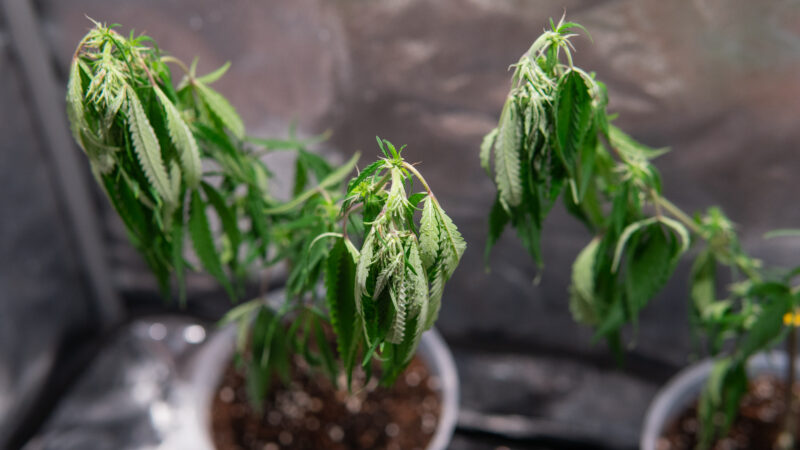
Underwatering, while less common than overwatering, can also stress cannabis plants and stunt their growth. When plants don’t receive enough water, they cannot transport nutrients effectively, leading to nutrient deficiencies and other health issues.
- Wilting with Dry Soil: If the soil is dry and the plant is wilting, it’s a clear sign of underwatering. The leaves may appear droopy, dry, and brittle, and the plant will look generally stressed.
- Crispy or Dry Leaves: In severe cases of underwatering, the leaves may become dry and crispy, particularly at the edges. This condition is often accompanied by browning or curling of the leaf tips.
- Slow Growth: Underwatered plants may show signs of slowed growth as they struggle to carry out photosynthesis and other essential functions due to a lack of water. New growth may be smaller than expected, and overall development can be stunted.
- Soil Pulling Away from Edges: Another sign of underwatering is when the soil starts to pull away from the edges of the pot. This indicates that the soil is very dry and compacted, which can make it difficult for roots to absorb water when it is finally applied.



